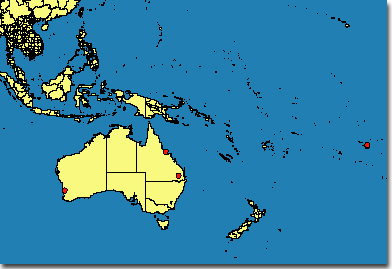 |
 |
||
|
|
|||
| Diagnosis | Encarsia sophia (Girault & Dodd) |
|||||||||||||
| Species group | ||||||||||||||
| Distribution | ||||||||||||||
| Host | ||||||||||||||
| Comments | ||||||||||||||
| Illustrations | ||||||||||||||
| DNA | ||||||||||||||
Coccophagus sophia Girault & Dodd, 1915: 49, 56. Syntypes female, Australia, Cairns (QM, Brisbane, type no. Hy. 2926). Prospaltella transvena Timberlake, 1926: 312-315. Holotype female, USA, Hawaii, Oahu, reared from Trialeurodes [as Aleyrodes] vaporariorum on tomato (BPBM, type no. 5690). Synonymy by Heraty & Polaszek, 2000: 163. Prospaltella sophia: Compere 1931: 11. Change of combination. Prospaltella sublutea Silvestri, 1931: 20-22. Syntypes female, Somalia, Duca [?], (IEUN). Synonymy by Gerling & Rivnay in Viggiani, 1985a: 90. Prospaltella bemisiae Ishii, 1938: 30. Syntypes female, Japan, Ikawa-cho, Mei-Ken, 25.viii.1932 (Iino), ex Parabemisia [as Bemisia] myricae Kuwana (NIAT). Synonymy with transvena by Polaszek et al., 1992: 388-389. Prospaltella flava Shafee, 1973: 254. Holotype female, India, Uttar Pradesh, Aligarh. Synonymy by Hayat, 1989: 72. Preoccupied by flavus Compere, 1936: 300. Synonymy questionable (Viggiani, 1985b) because type material reared from coccid. Encarsia sophia: Viggiani, 1985b: 249. Change of combination. Encarsia transvena: Gerling & Rivnay in Viggiani, 1985a: 90-92. Change of combination. Encarsia shafeei Hayat, 1986: 163. Replacement name for E. flava (Shafee). Encarsia transvena; Hayat, 1989: 71-73; 1998: 205-207; Polaszek et al., 1992: 388-389; Schauff et al., 1996: 31-33; Huang & Polaszek, 1998: 1954-1956. |
||||||||||||||
Diagnosis |
FemaleColourHead and body yellow, pronotum and axillae anteriorly and gaster occasionally slightly darkened. MorphologyClava 3-segmented. Head, including the area encompassed by the ocelli, with transversely strigose surface sculpture. Pedicel slightly longer than F1 (0.87-1.18). F1 about as long as F2 (0.86-1.07) and F3 (0.85-1.10). Mid lobe of mesoscutum with 8-10 setae. Scutellar sensilla close together, separated by a distance of about their width or less. Distance between anterior pair of scutellar setae distinctly smaller than between posterior pair. Fore wing with a patch of longer setae near hind margin, 2.6-2.7 x as long as wide. Marginal fringe 0.32-0.43 x as long as wing width. Tarsus of middle leg 5-segmented. Apical spur of middle tibia slightly longer than half the length of the basal tarsal segment (0.62- 0.66). Ovipositor 1.13-1.23 x the length of the middle tibia and 1.56-2.08 x as long as clava. Third valvula 0.24-0.33 x as long as second valvifer. |
|||||||||||||
Species
|
Placed in E. strenua-group by Polaszek et al. (1992). |
|||||||||||||
Distribution
|
 Click here for material examined window. |
|||||||||||||
Host |
B. tabaci (Gennadius), T. vaporariorum (Westwood). The following additional hosts have been recorded (Huang & Polaszek, 1998): Aleurocybotus indicus David & Subramaniam, Aleurodicus dispersus Russell, Dialeurodes citri Russell, Parabemisia myricae (Kuwana), Pealius longispinus Takahashi (with Bemisia afer (Priesner & Hosny)). |
|||||||||||||
Comments |
The identification of E. protransvena is difficult and the species has in the past been confused with E. strenua (Silvestri) and E. citri (Ishii) (Polaszek et al., 1992; Schauff et al., 1996). Encarsia strenua has not been found in the Australian region and can be separated by its longer ovipositor, which is more than 1.6 x the length of the middle tibia in E. strenua and 1.3-1.5 x in E. protransvena (with few exceptions, see Heraty & Polaszek, 2000). All these species belong to a group of cryptic species within the E. strenua-group (Huang & Polaszek, 1998; Heraty & Polaszek, 2000). |
|||||||||||||
Illustrations |
|
|||||||||||||
DNA
|
28S-D2 rDNA: GenBank Accession Code: AF254195-AF254207. | |||||||||||||
| © Copyright 2001, CSIRO Australia |
| [webmaster - February 2001] |
| Use of this web site and information available from it is subject to our |
| Legal Notice and Disclaimer |